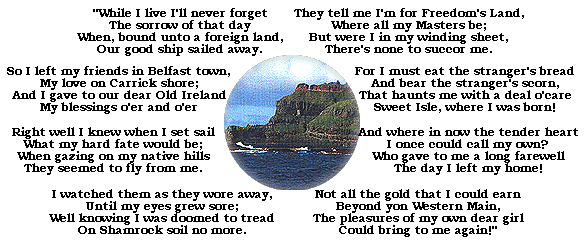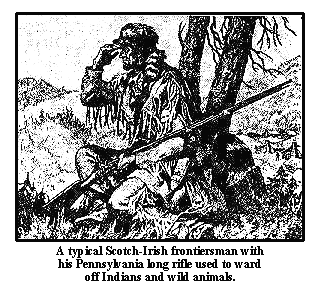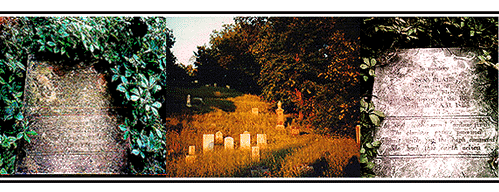Samuel Blair was born in Ballyvallough (near
Raloo), County Antrim, n. Ireland in 1738. His nickname,
"The Renegade", was given to him years after his death by Blair family
historians. It was used as a means of distinguishing him from the many other Sam
Blair's who were America in the 1700's. The name was chosen because of
his daring escape from the hangman's noose in northern Ireland. Following is the
poem, written by Sam while sailing to America, and the story behind his escape that was
published in the November 1927 issue of the "Blair Magazine."
FAREWELL TO ERIN
by Samuel Blair, "A Hearts of Steel Man"

These lines were written by Samuel Blair, of
Ballyvallough, a leader in the Hearts O'Steel Rebellion
in Ireland, 1770. He was captured and condemned to death, but escaped through the
cleverness of his twin sister, Mary. The Heart O'Steel Rebellion, it may be said,
was an uprising of the Irish tenantry to protest against the unjust taxation imposed upon
them in the time of George III, and its spirit was largely the inspiration of the American
Revolution, a few years later. These patriots were unsuccessful; many were put to
death; and some--as shown herein--escaped to the New World. Many of them also
served, Scotch-Irish Patriots, in the land of their adoption.
The story of the escape of Samuel Blair is one of
the most charming of all those we have found. Samuel and Mary, as we have said were
twins. Mary had just borne her first child when the news was brought to her of the
capture and condemnation of her brother. She rose from her bed, dressed, and mounted
her horse, riding for her farewell visit with the best-loved brother. She was
permitted but a short stay with him, but when she left the prison she was weeping so
heart-brokenly that it was with difficulty she could mount her horse and ride away.
The execution was set for some two or
three days later. When the victim was led onto the scaffold, and before the noose could be
adjusted, he stepped forward and threw open his coat, and , says the fascinating record,
"there were fair white breasts dripping with suck," One soldier, whose quick
perception must always thrill us, cried instantly aloud; "We’ve been fooled!
We’ve been fooled! Its a woman!
The brief visit of farewell had,
of course, been spent in the exchange of clothing, and Samuel had ridden away---with full
speed, as we may imagine, when once out of sight of the prison---and taken passage in a
vessel happily ready to sail to the New World. Mary, runs the tale, was taken before the
King, and there she told her story. The monarch "bowed his head and the tears ran
heavy over his cheeks as he bade her go her way, back to her babe. And, said he as he
watched her going, "Would to god that some one loved me so!"
Samuel, of necessity, left without
farewells---other than to Mary. No chance was there even for a farewell to the sweetheart
who, we feel, should have joined him later. He arrived in Philadelphia; later settled in
Central Pennsylvania on the shores of the Susquehanna. About 1796 he removed to Crawford
County, Pennsylvania (in the north-western part of the state), where he died, it is said,
in 1820. He married a young widow, Mrs. Ann Young, and left a number of children. His
grave is in Mt. Blair cemetery, near Meadville, Pennsylvania. His nephew, Patrick Blair,
who came over in 1835, is buried near him.
Sam's thirst for adventure might have been
quenched after the above experience but either out of natural taste for it or out of
necessity his adventures continued in the New World. We believe he landed in
Philadelphia in the years just prior to the start of the
American Revolution. He was probably in
the company of other banished rebels all with a deep grudge against the British.
According to the Crawford County Veterans Office and a Revolutionary War marker on his
grave he served as a Captain in Pennsylvania's 1st Regt., Continental Line from
November 1775 to November 1776, but no confirming records have ever been located to
substantiate this. Knowing his love of a good fight, however, it would be hard to
imagine he didn't take the opportunity to do in a few British soldiers.
After his skirmishes with the British, Sam seems to have disappeared
into the frontier of Pennsylvania for a few years. Records were few in the
backwoods, but it is known that he settled somewhere on the banks of the Susquehanna
River, which was at the edge of settled territory. The
Scotch-Irish often led the way
into the frontier as they were more accustomed to the hardships it brought.
 They were hearty souls on the
order of Davy Crockett who could "leap the Ohio, ride upon a streak of lightning, and
slip without a scratch down a honey locust; could whip his weight in wild cats- and if any
gentleman pleases, for a ten dollar bill, he may throw in a panther--hug a bear too close
for comfort, and eat any man opposed to Jackson!" As you can see they
could also spin a good yarn. The Scotch-Irish women were just has hearty as described here
by historian H. C. McCook: They were hearty souls on the
order of Davy Crockett who could "leap the Ohio, ride upon a streak of lightning, and
slip without a scratch down a honey locust; could whip his weight in wild cats- and if any
gentleman pleases, for a ten dollar bill, he may throw in a panther--hug a bear too close
for comfort, and eat any man opposed to Jackson!" As you can see they
could also spin a good yarn. The Scotch-Irish women were just has hearty as described here
by historian H. C. McCook:
Stalwart of frame no doubt they were,
with muscles hardened under the strain of toil; hale and hearty, vigorous and strong, able
to wield the axe against the trunk of a forest monarch or the head of an intruding savage;
to aid their husbands and fathers to plow and plant, to reap and mow, to rake and bind and
gather. They could wield the scutching knife or hackling comb upon flaxen stocks of
fibers, as well as the rod of rebuke upon the back of a refractory child. They could
work the treadle of a little spinning wheel, or swing the circumference of the great
one. They could brew and bake, make and mend, sweep and scrub, rock the cradle and
rule the household.
Sam married Mrs. Ann Young sometime before 1777 as that was
the year their first child, Margaret, was born. Little is known about Ann Young, not
even her maiden name. It is known that she was a widow with a daughter by her first
marriage and this daughter later married a gentleman by the name of Thomas Gilmore.
Sam and his nearly grown children moved on in search of yet another
frontier in 1794. They took title to land on French Creek in
northwestern Pennsylvania, later to become Woodcock Township, Crawford County. This
land had just recently been opened to settlers and Sam and his family were among the
first of this daring breed of trail blazers to enter the land in that region.
There is
evidence that other Scotch-Irish friends, family and neighbors came about the same time
or soon after.
He carved out a home in this new wilderness and lived out the remainder of
his days. He and Ann are buried in Mt. Blair cemetery near Woodcock, Pennsylvania. This
was originally a family cemetery on Sam's farm which later became a public burial ground.
Most of those buried there are member's of Sam's family or close friends and
neighbors. The cemetery sits aside a steep hill with Sam and Ann resting at its highest
point.

Pictured on the left is the gravestone of Samuel Blair and on the right his wife,
Ann's. Although difficult to read in this photograph, they are actually in remarkable
condition today, especially Ann's. Part of the cemetery is pictured in the middle.
Sam and Ann rest at the top of this hill with a remarkable view of the valley below. Both
of these stones are large slabs that rest flat on the ground. Their stones read:
In memory of Samuel Blair
A native of Ireland
aged 82 years
He died Aug. 7th A.D. 1820
"Cease all from sorrowing and tears
Here I must lie till Christ appears
Then burst the tomb in sweet surprise
And in my Savior's image rise."
*
Veteran of the Revolutionary War Marker at upper right of stone
In memory of Ann Blair
Consort of Samuel Blair
She departed this life April 16th A. D. 1823
Aged 73 years
"Her soul with sacred ardour fir'd
The glorius prize pursued
To meet with joy the high command
She bade this earth adieu." |

 They were hearty souls on the
order of Davy Crockett who could "leap the Ohio, ride upon a streak of lightning, and
slip without a scratch down a honey locust; could whip his weight in wild cats- and if any
gentleman pleases, for a ten dollar bill, he may throw in a panther--hug a bear too close
for comfort, and eat any man opposed to Jackson!" As you can see they
could also spin a good yarn. The Scotch-Irish women were just has hearty as described here
by historian H. C. McCook:
They were hearty souls on the
order of Davy Crockett who could "leap the Ohio, ride upon a streak of lightning, and
slip without a scratch down a honey locust; could whip his weight in wild cats- and if any
gentleman pleases, for a ten dollar bill, he may throw in a panther--hug a bear too close
for comfort, and eat any man opposed to Jackson!" As you can see they
could also spin a good yarn. The Scotch-Irish women were just has hearty as described here
by historian H. C. McCook: